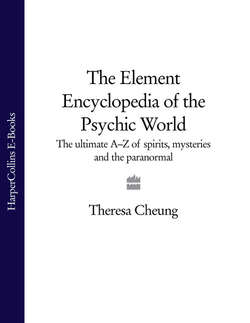Читать книгу The Element Encyclopedia of the Psychic World: The Ultimate A–Z of Spirits, Mysteries and the Paranormal - Theresa Cheung, Theresa Cheung - Страница 78
AURA
ОглавлениеThe name given to a subtle envelope of vital energy that is thought to radiate round natural objects, including human beings, animals and plants. The colours and forms of each aura are believed to be characteristic of the person, animal or thing it surrounds and to fluctuate and shift according to mood and state of health.
The aura is normally invisible, but it can be seen by clairvoyants as a halo of light and colour. Two clairvoyants viewing the same aura might see different colours or interpret it in different ways. State of health and a person’s emotions show up as differences in colours and energy patterns or breaks in an aura. Physical illness seems related to the part of the aura that is closest to the body, often called the etheric body. Some psychics see the aura as a psychic screen for the projection of information, past, present and future.
Although the body does have a magnetic field - a biofield - there is no scientific evidence that auras exist. However, the belief that the human body emits radiations of a kind that in certain circumstances becomes visible has been encountered for centuries, and was present in ancient Egypt, India, Greece and Rome. In the sixteenth century, discourses on the astral body and its ‘fiery aura’ abound, and in the eighteenth century the theory of animal magnetism was developed by Anton Mesmer, who promoted a variety of scientific experiments to try to identify the phenomenon.
Just before World War I, Dr Walter Kilner from St Thomas’s Hospital in London developed a method to view auras, which he claimed appeared as a faint haze around the body, using an apparatus that rendered ultraviolet light visible. His theory of auric diagnosis of illness linked the appearance of an aura to a patient’s health. Kilner’s work was greeted with scepticism and interrupted by the outbreak of hostilities. In 1939, Semyon Davidovich Kirlian, a Russian electrician, developed a technique that he claimed recorded auras on film, but this technique remains to be verified. See Kirlian photography.
Auras, like parking places, are easy to find when you aren’t looking for them. So if you want to see an aura, you need to feel as relaxed and calm as possible. Breathe slowly and deeply for a few minutes. Then, instead of looking directly at someone, look straight past them and casually glance in their direction, allowing your eyes to lose focus. The idea is to trick your rational brain by deliberately putting a lot of your concentration on something else, but to keep a vague focus on the person whose aura you want to read.
With practise you may see a dim haze of energy around someone. Keep breathing deeply, and the aura may brighten to a colour. Don’t expect people to light up like Christmas trees and stay that way. Visions of auras tend to be lightning quick, but the more you practise the more natural it will feel and the more likely it is for colour to become noticeable. To find out what different auric colours could mean, see Colour divination.
